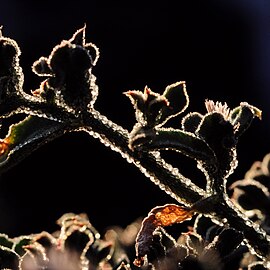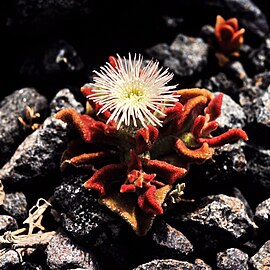Mesembryanthemum crystallinum
| Common iceplant | |
|---|---|

| |
| Mesembryanthemum crystallinum flowering in Lanzarote | |
| Scientific classification | |
| Kingdom: | Plantae |
| Clade: | Tracheophytes |
| Clade: | Angiosperms |
| Clade: | Eudicots |
| Order: | Caryophyllales |
| Family: | Aizoaceae |
| Genus: | Mesembryanthemum |
| Species: | M. crystallinum
|
| Binomial name | |
| Mesembryanthemum crystallinum | |
| Synonyms | |
|
Cryophytum crystallinum (L.) N.E.Br. | |
Mesembryanthemum crystallinum is a prostrate
Description
Mesembryanthemum crystallinum grows creeping stems, from 20–60 centimetres (8–23+1⁄2 inches) in length.
The species is covered with enlarged epidermal cells, called "bladder cells", the main function of which is to reserve water.[3] The plant can be annual, biennial or perennial, but its life cycle is usually completed within several months, depending on environmental conditions.[3]
Biology
The plant usually uses
In M. crystallinum, the number of seeds produced depends on whether CAM has been activated (C3 metabolism is more efficient) and the size the plant has grown to in its juvenile growth phase. Older portions of the plant progressively die off and dry out during seed production. The developing seed capsules continue to sequester salt and produce viable seeds. Seeds at the top of the capsule generally germinate immediately on imbibation, while seeds at the base may remain dormant for longer than four weeks.[3]
Distribution and habitat
Mesembryanthemum crystallinum is native to Africa, Sinai and southern Europe, and naturalized in the Southwest of North America,[2] as well as in South America and Australia.[1] It is found on a wide range of soil types, from well-drained sandy soils (including sand dunes), to loamy and clay soils. It can tolerate nutritionally poor or saline soils (halophile), and grows well in disturbed sites such as roadsides, rubbish dumps and homestead yards.[3]
Ecology
M. crystallinum is listed as an invasive species in North America, South America, and Australia.[5][6][7] Its ability to grow in poor quality or saline soils and preference for disturbed areas are traits shared by many invasive plants which enable them to outcompete native species. In addition salt sequestration over the plant's lifetime, and the subsequent leaching into the soil upon its death, create an environment in which other plant's seeds struggle to germinate, allowing for the colonization of new areas with very little competition.[3][7]
The plant is rarely, if ever, grazed upon by domestic stock.[3]
Uses

The leaves are edible,
The crushed leaves can be used as a soap substitute and have medicinal uses.[3] Ice plants are also used in South Africa as a way of deterring fires, or "firescaping" gardens.[8] It is also cultivated for ornamentation.[1] Due to its salt accumulation, M. crystallinum may be useful for bioremediation.[3]
References
- ^ a b c "Taxon: Mesembryanthemum crystallinum L." Germplasm Resources Information Network (GRIN). United States Department of Agriculture, Agricultural Research Service. Retrieved 2017-06-22.
- ^ ISBN 978-0-375-40233-3.
- ^ a b c d e f g h i j k "Mesembryanthemum crystallinum L." Water for a Healthy Country. CSIRO. Retrieved 2014-04-14.
- .
- ^ "Mesembryanthemum crystallinum Profile". California Invasive Plant Council. 2017-03-20. Retrieved 2022-03-16.
- ^ Wilson, Nick (2017-04-01). "WEED NOTE Mid-West: Ice plant (Mesembryanthemum crystallinum)" (PDF). Shark Bay World Heritage Area. Astron Environmental Services Pty Ltd. Retrieved 2022-03-16.
- ^ JSTOR 1942519.
- ^ ISBN 0415927463.
- ^ Desaki, Yutaro (2009-11-28). "Universities bringing research to the plate". The Japan Times. Retrieved 2021-02-21.
External links
 Media related to Mesembryanthemum crystallinum at Wikimedia Commons
Media related to Mesembryanthemum crystallinum at Wikimedia Commons- Chisholm, Hugh, ed. (1911). . Encyclopædia Britannica. Vol. 14 (11th ed.). Cambridge University Press. p. 241.





